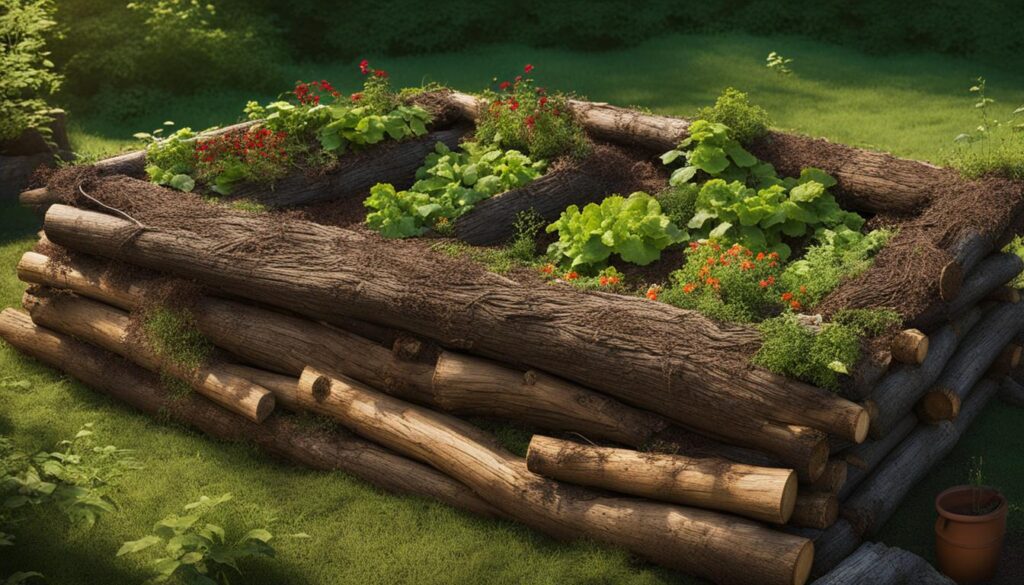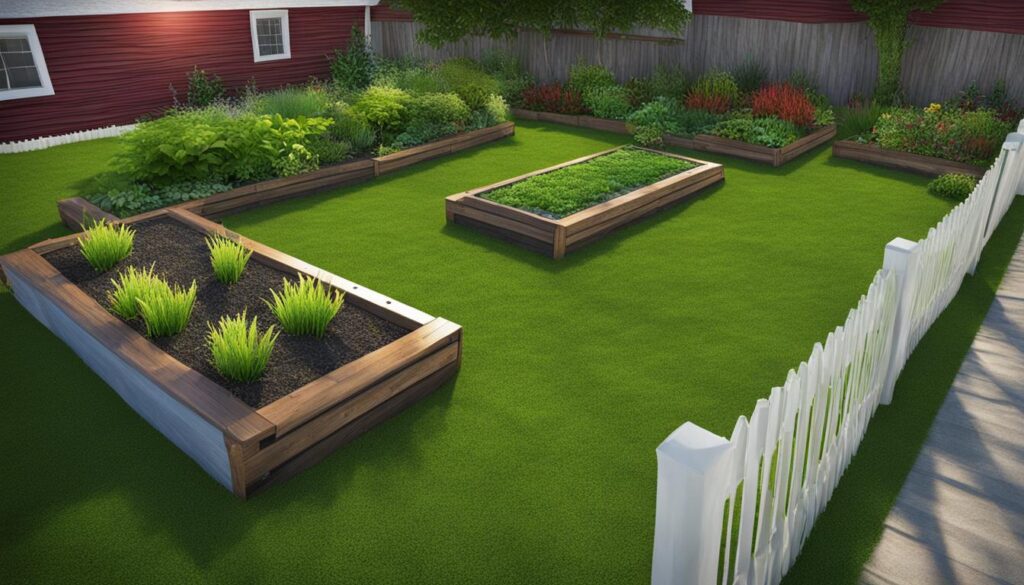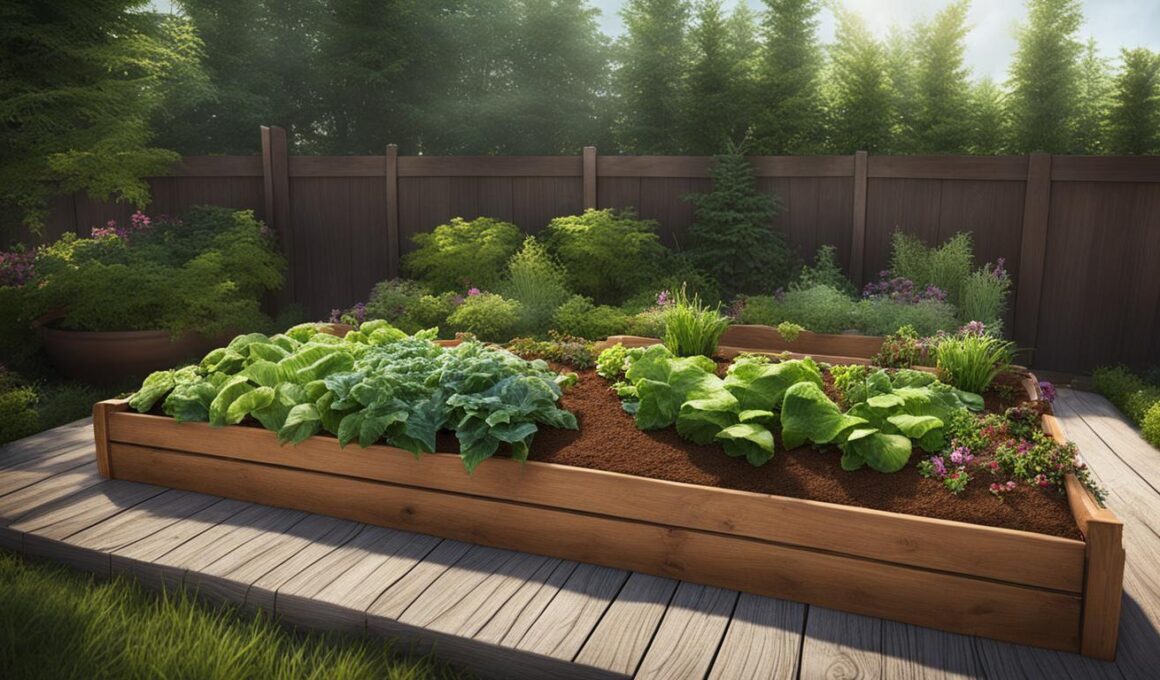When it comes to raised garden beds, it’s essential to consider what you put between them for optimal results. Choosing the right materials and strategies can help prevent weeds and promote healthy growth in your garden. Here are some gardening tips to help you make the most out of your raised garden beds:
Post Summary:- Selecting the appropriate materials between your raised garden beds is crucial for weed prevention and healthy plant growth.
- Consider incorporating landscaping features, such as a river rock border or a paver stone path, to enhance the aesthetics and deter weed growth.
- Explore the Hugelkultur method, which involves filling the bottoms of raised beds with sticks or logs, to potentially improve soil productivity and pH levels.
- Take advice from experienced gardeners who recommend materials like landscaping fabric, paving slabs, or carpet remnants for effective weed suppression.
- Implement weed control strategies like using pea gravel, cardboard, or mulch to combat persistent weeds and grass in your raised garden beds.
By following these gardening tips and finding the right solutions for your raised garden beds, you can create a thriving garden with minimal weed interference and promote healthy plant growth.
Landscaping Ideas for Raised Garden Beds
Personalizing your raised garden beds with landscaping features can not only enhance the visual appeal of your garden but also provide functional benefits. Here are some ideas to consider:
1. River Rock Border
Add a river rock border around your raised garden beds to create a natural and visually appealing edge. The rocks can help prevent weeds from encroaching into your garden while adding a touch of elegance. Arrange the rocks in a pattern that complements your garden design and consider using larger rocks as focal points.
2. Paver Stone Path
A paver stone path leading to your raised garden beds can be both practical and aesthetically pleasing. Choose square paver stepping stones that complement the overall style of your garden and provide a stable surface for walking. A well-designed pathway can make it easier to access your garden beds and maintain them.
3. Ground Cover
Another landscaping option for your raised garden beds is to incorporate ground cover plants. This can help fill in empty spaces between the beds and create a lush and cohesive look. Select low-growing, drought-tolerant plants that can thrive in your garden’s microclimate and provide added benefits like weed suppression and soil erosion prevention.
4. Mulch
Using mulch around the base of your raised garden beds can help retain moisture, regulate soil temperature, and reduce weed growth. Choose organic mulch materials like wood chips or straw that not only provide these benefits but also break down over time, enriching the soil. Apply a layer of mulch around your garden beds, ensuring it does not touch the plant stems.
By incorporating these landscaping ideas into your raised garden beds, you can create a beautiful and functional outdoor space while promoting healthy plant growth and minimizing weed issues.
| Landscape Feature | Benefits |
|---|---|
| River Rock Border | Enhances aesthetics Prevents weed encroachment |
| Paver Stone Path | Facilitates access to garden beds Provides stability |
| Ground Cover | Fills empty spaces Prevents weeds and soil erosion |
| Mulch | Conserves moisture Moderates soil temperature Reduces weed growth |
Exploring the Hugelkultur Method in Raised Beds
The Hugelkultur method is a unique and innovative approach to gardening that involves using sticks or logs as a foundation for raised garden beds. Originally designed for mounds or rows in the ground, this technique has gained popularity among certain gardeners who wish to experiment with alternative gardening methods.
By filling the bottoms of raised garden beds with sticks or logs, the Hugelkultur method aims to improve soil productivity and pH levels over time. As the organic matter decomposes, it releases nutrients into the soil, providing a sustainable source of nourishment for plants. This process can also help to retain moisture and promote better drainage, creating an ideal growing environment for various crops and plants.
The Hugelkultur method involves utilizing organic materials to mimic the natural processes that occur in a forest ecosystem, where fallen trees and plants contribute to the fertility of the soil. By incorporating this method in raised beds, gardeners can harness the benefits of nutrient-rich soil and create a thriving garden space.
Key Benefits of the Hugelkultur Method in Raised Beds
- Improved soil productivity: The decomposition of sticks and logs releases nutrients into the soil, providing a continuous source of nourishment for plants.
- Enhanced moisture retention: The organic matter in the raised beds acts as a sponge, helping to retain moisture and reduce the need for frequent watering.
- Better drainage: The air pockets created by the decomposing organic matter promote better drainage, preventing waterlogged soil and root rot.
- Natural weed suppression: As the organic matter decomposes, it can create an inhospitable environment for weed growth, reducing the need for chemical weed control.
- Long-lasting benefits: The Hugelkultur beds continue to improve over time as the organic matter breaks down, providing ongoing benefits to plants.
While the Hugelkultur method may not be suitable for all gardeners or growing conditions, it is worth considering as an alternative approach to raised bed gardening. Experimenting with different methods and techniques can help you discover what works best for your specific needs and preferences. By exploring the Hugelkultur method, you may uncover a whole new way to enhance the productivity and sustainability of your raised garden beds.

| Pros | Cons |
|---|---|
| Improves soil fertility | Requires a significant amount of organic material |
| Reduces the need for synthetic fertilizers | Takes time for the organic matter to decompose |
| Retains moisture and promotes better drainage | May attract pests or rodents |
| Natural weed suppression | Not suitable for all plant varieties |
Tips from Gardeners on What to Put Between Raised Garden Beds
When it comes to maintaining your raised garden beds, finding the right materials to put between them can make a significant difference in weed control and overall garden health. Gardeners have shared their experiences and recommendations, offering valuable insights to help you make an informed decision. Here are some popular tips from experienced gardeners:
Landscaping Fabric with Paving Slabs or Carpet Remnants
Gardeners have found success in using landscaping fabric as a weed suppressant between raised garden beds. By laying down the fabric, you create a barrier that prevents weeds from germinating and growing. Pairing the fabric with paving slabs or carpet remnants adds an attractive aesthetic element to your garden while providing additional protection against weed growth.
Cardboard and Plastic Sheeting
Another cost-effective and readily available option is to use cardboard or plastic sheeting between your raised garden beds. Simply lay the cardboard or plastic on the ground, overlapping the edges, and secure it in place. This method creates a barrier that restricts weed growth and can also help retain moisture in the soil.
Grass Clippings and Mulch
If you’re looking for an organic solution, consider using grass clippings or mulch between your raised garden beds. Grass clippings act as a natural weed suppressant while also providing nutrients to the soil as they decompose. Mulch, such as wood chips or straw, can also help prevent weed growth and retain moisture, ensuring your plants receive the necessary water and nutrients.
| Materials | Advantages |
|---|---|
| Landscaping fabric with paving slabs or carpet remnants | – Effectively suppresses weeds – Adds aesthetic appeal to the garden |
| Cardboard and plastic sheeting | – Cost-effective solution – Acts as a barrier against weed growth – Helps retain moisture |
| Grass clippings and mulch | – Organic weed suppressant – Provides essential nutrients to the soil – Retains moisture |
Ultimately, the choice of what to put between your raised garden beds depends on your preferences, budget, and specific needs. Consider factors such as weed control, aesthetics, and ease of maintenance when making your decision. Try out different materials and methods to find what works best for you and enjoy a weed-free, thriving garden.
Dealing with Weeds and Grass in Raised Garden Beds
Weeds can be a persistent issue in raised garden beds, but there are various strategies to combat them. One approach is to cut back weeds and grass, cover them with cardboard, and place a layer of pea gravel on top. This method helps prevent weed growth and can be easily managed when new weeds emerge. Additionally, using mulch around the outside of the beds can give your garden a polished look while further inhibiting weed growth.
“By incorporating a layer of cardboard between the soil and the pea gravel, you create a barrier that suppresses weed growth,” says experienced gardener Jane Smith. “The cardboard blocks sunlight, making it difficult for weeds to sprout and establish themselves.”
Pea gravel is an effective weed control measure because it allows water to penetrate through while providing a barrier to weed germination. The small, smooth stones hinder weed growth by limiting access to sunlight and creating an inhospitable environment for seeds to take root. Additionally, the gravel acts as a natural drainage system, preventing excess water buildup that can lead to weed proliferation.
Benefits of Using Mulch
Mulch is another valuable tool in the fight against weeds in raised garden beds. Applying a layer of organic or inorganic mulch around the outside of the beds not only enhances the aesthetic appeal of your garden but also helps smother weeds. Organic mulches, such as wood chips or straw, provide a natural barrier while improving soil health as they break down over time. Inorganic mulches, like rubber or plastic, offer long-lasting weed suppression without the need for frequent replenishment.
- Suppresses weed growth by blocking sunlight
- Retains soil moisture, reducing water evaporation
- Protects plant roots from extreme temperatures
- Prevents soil erosion
It’s essential to choose the right mulch for your raised garden beds based on your gardening goals, climate, and aesthetic preferences. Whether you opt for pea gravel, cardboard, mulch, or a combination of these methods, implementing effective weed control strategies will help you maintain a beautiful and productive garden.

Are Railroad Ties a Suitable Option for Creating Raised Garden Beds?
Using railroad ties for raised garden beds may seem like a convenient option due to their durability and rustic appeal. However, it’s important to consider their potential drawbacks. Railroad ties are treated with chemicals that could leach into the soil, harming plants and posing health risks. It’s advisable to explore alternative materials that are safe and environmentally-friendly for creating raised garden beds.
Conclusion
Deciding what to put between your raised garden beds is essential for maintaining a healthy garden and preventing weed growth. By following these gardening tips and implementing effective weed prevention strategies, you can promote healthy growth in your raised garden beds and enjoy a thriving garden.
Consider incorporating landscaping features like a river rock border or a paver stone path to enhance the aesthetics of your garden while deterring weeds. Ground cover and mulch can further beautify the area surrounding your raised beds.
Explore the Hugelkultur method, which involves filling the bottoms of your raised garden beds with sticks or logs. While the effectiveness of this technique may vary, it has gained popularity among some gardeners. Stay tuned for the results of an experiment comparing the productivity and pH levels of raised beds using sticks versus leaf mulch and soil.
Take advice from experienced gardeners who suggest using materials like landscaping fabric with paving slabs or carpet remnants for effective weed suppression. Other alternatives include cardboard, plastic sheeting, and grass clippings. Choose the right solution based on your soil conditions, aesthetic preferences, and weed control needs. Additionally, combat weeds by cutting them back, covering with cardboard, and adding a layer of pea gravel on top. Mulch can also be used to create a polished look and inhibit weed growth around the outside of your raised garden beds.
FAQ
What should I put between my raised garden beds?
There are several options to consider, such as landscaping features like a river rock border and paver stone path, ground cover, mulch, or even experimenting with the Hugelkultur method.
How can landscaping features enhance my raised garden beds?
Landscaping features like a river rock border and paver stone path can not only improve the aesthetics of your garden but also help deter weeds.
What is the Hugelkultur method, and is it suitable for raised garden beds?
The Hugelkultur method involves filling the bottoms of raised garden beds with sticks or logs. While there are varying opinions on its effectiveness, it has gained popularity among certain gardeners. Stay tuned for the results of an experiment comparing this method with other options.
What do gardeners suggest putting between raised garden beds?
Gardeners have shared various suggestions, including using landscaping fabric with paving slabs, carpet remnants, cardboard, plastic sheeting, or grass clippings. The choice depends on factors like soil conditions, aesthetics, and weed control preferences.
How can I deal with weeds and grass in my raised garden beds?
One approach is to cut back weeds and grass, cover them with cardboard, and place a layer of pea gravel on top. Additionally, using mulch around the outside of the beds can help inhibit weed growth.







